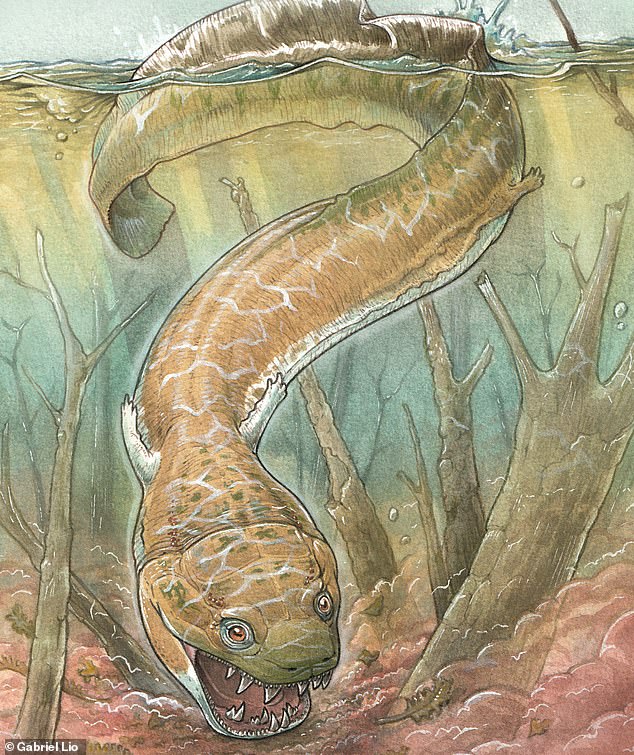- Gaiasia jennyae lived 300 million years ago in a region of present-day Namibia.
- Researchers believe it used its toilet seat-shaped head to catch large prey.
Forty million years before dinosaurs roamed the Earth, a much stranger monster sat at the top of the food chain.
Scientists have discovered the fossilized remains of a giant salamander-like monster nearly two meters long and with a huge “toilet seat-shaped head.”
This terrifying creature, named Gaiasia jennyae after the Gai-as Formation in Namibia where it was found, is believed to have lurked in swamps and lakes, devouring anything that came near.
And with a skull more than two feet long and a set of impressive interlocking tusks, paleontologists believe Gaiasia would have been a fierce ambush predator.
Co-lead author Dr Jason Pardo, from Chicago’s Field Museum, said: “It has a large, flat head, shaped like a toilet seat, which allows it to open its mouth and suck in its prey.”
Scientists have discovered a terrifying prehistoric predator with a huge “toilet seat-shaped head” (photo: artist’s impression)

One of the specimens was so well preserved that researchers were able to find an articulated skull and spine hidden in the rock.
Although Namibia is just north of South Africa today, 300 million years ago it would have been much further south, near the northernmost point of present-day Antarctica.
At that time the Ice Age was coming to an end and the lands closest to the equator were drying out and becoming forested.
But in the warmer areas near the poles there were still swamps and lakes where this strange new species could live.
Dr. Pardo and his co-author Claudia Marsicano of the University of Buenos Aires discovered the fossilized remains of four creatures in a rock formation dating back 280 million years.
Considerably larger than a person (over 1.80 metres) and with a huge skull and massive tusks, Gaiasia would have been a terrifying but slow ambush hunter.
Dr Marsicano says: ‘When we found this huge specimen lying on the outcrop as a giant concretion, it was really shocking.
“When I saw it, I knew it was something completely different. We were all very excited.”

This creature gets its name from the Gai-as Formation in Namibia, where it was found in a rock face dating back 280 million years.

Researchers discovered four well-preserved specimens of Gaiasia jennyae in a region of present-day Namibia

Researchers believe Gaisia (pictured) would have been a fearsome, if slow, ambush predator that lurked at the bottom of lakes and swamps.
One of these specimens was particularly well preserved, featuring an articulated head and spine that reveal an extremely unusual feature.
Gaiasia’s skull showed a highly unusual set of large, interlocking tusks that created a bite unique to early tetrapods – the four-limbed vertebrates that evolved from lobe-finned fish and gave rise to amphibians, reptiles, birds and mammals.
Dr Pardo says: ‘It has these huge fangs, the whole front of its mouth is just giant teeth’
This unusual jaw structure would have allowed this ambush predator to catch and hold large prey in the prehistoric swamps of Namibia.
These are the characteristics that made it one of the main predators of the prehistoric ecosystem.

Researchers were surprised to discover that the ancient animal had a full set of interlocking tusks, which was highly unusual for creatures from this period.

Gaisia is an evolutionary remnant related to species that became extinct 40 million years ago, however, researchers believe it would have been one of the main predators in its ecosystem.
The first known dinosaurs appeared during the Triassic Period, approximately 250 to 200 million years ago, but Gaiasia predates them by 40 million years.
Dr Pardo says: ‘There are other more archaic animals that still survived 300 million years ago, but they were rare, they were small and they did their thing.
‘Gaisia is large and abundant and appears to be the top predator in its ecosystem.’
The species is further detailed in a new study published today in Nature.



